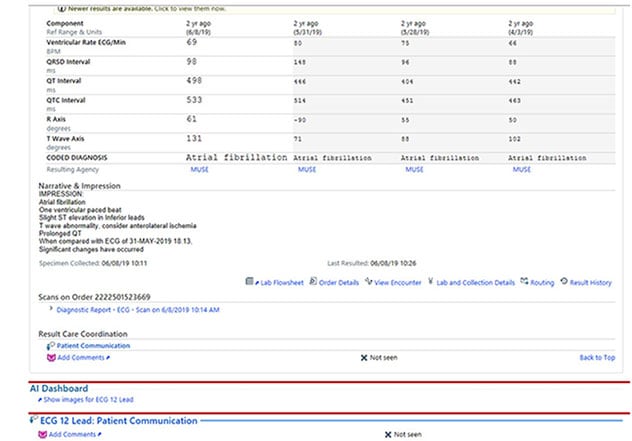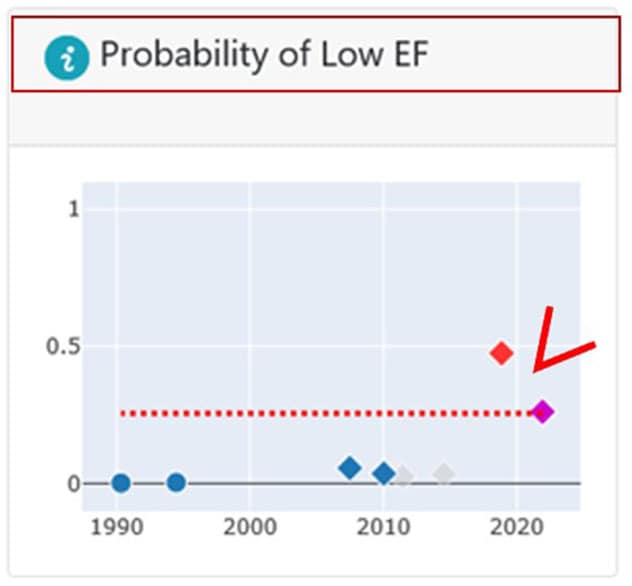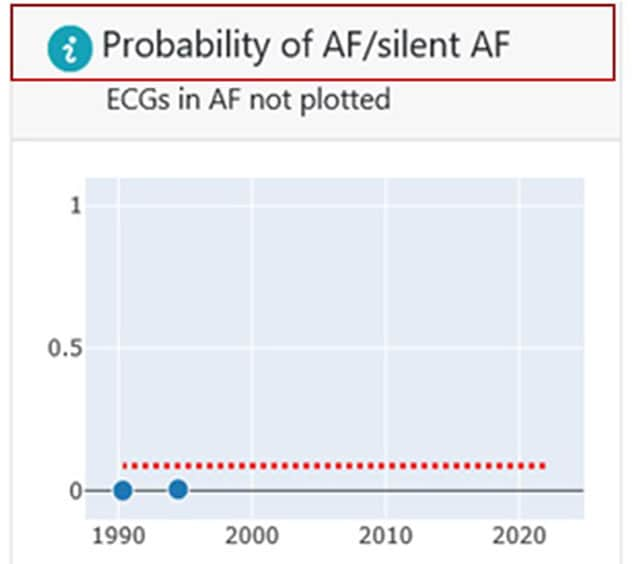Jan. 14, 2022
The association of hyperthyroidism with atrial fibrillation (AF) and heart failure is widely recognized. Both conditions result in increased morbidity and mortality. To understand whether patients with Graves' disease who are at very high risk for these conditions can be identified, a team of cardiologists and endocrinologists at Mayo Clinic's campus in Rochester, Minnesota, evaluated a large cohort of patients with Graves' disease in medical records going back more than a decade.
电子健康记录中的 AI ECG 工具

电子健康记录中的 AI ECG 工具
这个人工智能(AI)心电图(ECG)工具现在已被纳入电子健康记录,可以通过选择 Epic 系统中的 ECG 进行访问。在报告中,有一个 AI 仪表板的部分(由红色矩形突出显示)。
低 EF 的概率

低 EF 的概率
AI ECG 工具为本研究中使用的每张心电图(ECG,Y轴)给出了 0(或 0%)到 1(或 100%)之间的概率。对于这名患者,低射血分数(EF)的概率最初较低,但在最后两张 ECG 中变得较高(最后两点,箭头)。这预示着低 EF 值(<50%)的发展,这在一年后的 ECG 上被检测到。红色水平虚线是 AI ECG 工具提供的与年龄和性别有关的备用分界线,表示发生该结果的风险的二元值(正或负)。
患AF 和无症状 AF 的概率

患AF 和无症状 AF 的概率
AI ECG 工具对本研究中使用的每张心电图(ECG,Y轴)给出了 0(或 0%)和 1(或 100%)之间的概率。这名患者患心房颤动(AF)和无症状 AF 的概率为0。红色水平虚线是 AI ECG 工具提供的与年龄和性别有关的交替分界线,表示发生该结果的风险的二元值(正或负)。
"It is clinically pertinent to identify the subset of patients with Graves' disease at increased risk of developing AF and heart failure who may benefit from closer surveillance and prompt restoration of euthyroidism" says Jwan A. Naser, M.B.B.S., a resident with Internal Medicine and Cardiovascular Medicine. "We found that, in a large population undergoing clinically indicated electrocardiograms (ECGs), artificial intelligence (AI)-enabled ECGs using a convolutional neural network identified the signature of silent AF in ECGs obtained while patients were in sinus rhythm. The signature of low ejection fraction also was identified for each ECG performed, with areas under the curve for silent AF and low ejection fraction of 0.87 and 0.93, respectively. This AI-enhanced ECG is now available in the electronic medical record at Mayo Clinic and gives a probability number between 0 and 1 for having silent AF and low ejection fraction."
Marius N. Stan, M.D., Endocrinology, Diabetes and Metabolism, at Mayo Clinic in Minnesota notes, "We applied this AI ECG tool to more than 400 patients diagnosed with Graves' disease over the past decade at Mayo Clinic who had ECGs around the time of diagnosis. We found that the AI ECG-derived probabilities of silent AF and low ejection fraction was an independent risk factor for the development of incident AF and heart failure with reduced ejection fraction (HFrEF), respectively."
"We also found that multivariate models that included the AI ECG in addition to conventional risk factors for AF and HFrEF in hyperthyroidism — including older age, overt hyperthyroidism, and comorbidities — significantly improved the predictive ability of the AI ECG tool. We are currently planning to build a risk score tool to identify patients at highest risk of AF and HFrEF," says Sorin V. Pislaru, M.D., Ph.D., Cardiovascular Medicine, at Mayo Clinic in Minnesota.
"This project is an excellent example of how different specialities can collaborate through the harnessing of technological advances for the sake of better patient care," concludes Grace Lin, M.D., M.B.A., Cardiovascular Medicine, at Mayo Clinic in Minnesota. Study outcomes were published in the Journal of the American College of Cardiology and the European Journal of Heart Failure in 2021.
For more information
Naser J, et al. Artificial intelligence helps identify patients with Graves' disease at risk for atrial fibrillation. Journal of the American College of Cardiology. 2021;77:319.
Naser JA, et al. Role of artificial intelligence in identifying patients with Graves' disease at high risk for heart failure with low ejection fraction. European Journal of Heart Failure. 2021;23(suppl S2):61.
Refer a patient to Mayo Clinic.